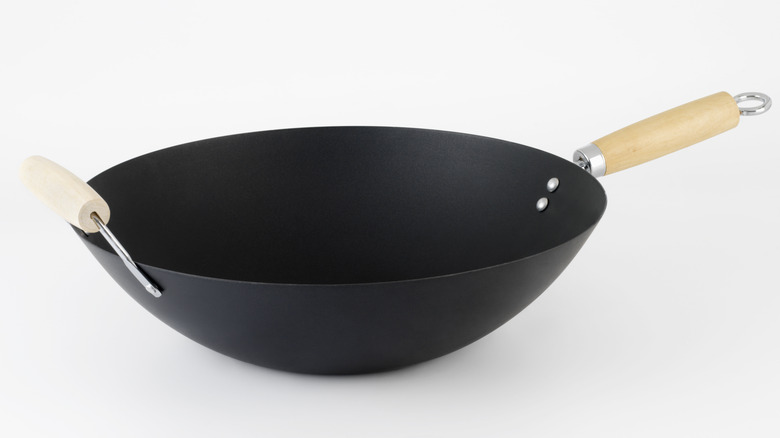Why Buying A Flat-Bottomed Wok Is Your Best Bet
The wok has been around for about 3000 years and is such a well-designed pan that it has had relatively few developments in its design during this time. Although woks can vary in size and material, the traditional wok always has a concave base. This concave shape has two functions. First, it ensures that heat is distributed efficiently and evenly from the heat source at the base of the pan up its sloping sides. Second, the rounded base is resistant to warping — essential when you consider the high heat generated by a wok burner.
The wok was first popularized in China and Southeast Asia, where kitchens and outdoor cooking spaces evolved with the wok, ensuring their rounded base could be placed above a powerful heat source and remain stable. Wok-based cooking has now become popular around the world, however in many countries particularly outside of Asia, the typical stovetop has flat heating elements, or is designed for flat-based pots and pans.
Enter the flat-bottomed wok. With similarly sloped sides, flat-bottomed woks provide many of the benefits of the traditional wok, but their flat base makes them far better at transferring heat from flat stovetops. This makes it much more versatile and practical for a kitchen setup that isn't designed for the classic round-bottomed wok. In fact, with a little practice, a flat-bottomed wok could turn into your one-pan solution for everything from pan-frying to steaming.
Which flat-bottomed wok should you choose?
Depending on the material they're made from (usually carbon steel, stainless steel, cast iron, copper, or aluminum), flat-bottomed woks can be compatible with almost every western range heat source, including electric, induction, and gas. However, copper is not magnetic, can dent easily, and requires maintenance, so it may be best to avoid this material when choosing a wok for home cooking.
Although many widely known dishes such as stir-fry and shrimp fried rice use a wok for frying, the traditional wok was designed to be a versatile one-pan solution for many different types of cooking. You can use a wok for braising, roasting, smoking — almost anything you can think of! A flat-bottomed wok takes versatility even further thanks to its larger base surface area, meaning it can hold more ingredients than its round-bottomed counterpart. Find yourself a flat-bottomed wok with a lid, and its potential goes even further: Use it to boil, steam, or poach food, with the confidence that it's not going to tip over thanks to its flat base.
A key question when choosing a flat-bottomed wok is how large the bottom surface should be. Some have tiny flat bottoms and others, sometimes called wok pans, have bottoms with a similar surface size to a pan. A smaller bottom will need less oil to cook ingredients, whereas a larger bottom will provide more stability.
The drawbacks of cooking with a flat-bottomed wok
There is a downside to cooking with flat-bottomed woks. They aren't made for tossing ingredients in a circular 'wok toss' motion, unlike rounded woks which are perfectly shaped for this. Instead, you should toss a flat-bottomed wok the same way you would toss ingredients in a sauté pan.
The angles in a flat-bottomed wok make it more challenging to stir ingredients, which can lead to them cooking unevenly. To avoid this, you may want to use a silicone spatula or wooden spoon instead of a rounded wok spatula, as they are better suited to scraping ingredients from the wok's edges before they stick and burn. Also, ingredients can catch more easily in a flat-bottomed wok, so it can take more effort to clean them properly. If you need to scrub your wok vigorously after each use, it's not only going to wear down quickly, it's likely to lose lots of its patina — one of the essential elements of wok cooking — that is created when you season your wok.
When cooking at home, your choice of flat-bottomed or rounded wok is a question of functionality and personal preference. Although you're unlikely to achieve peak 'wok hei', you won't necessarily be sacrificing much flavor using a flat-bottom wok to cook even the most classic wok recipes. For example, although this might not be the authentic approach, you don't necessarily need a wok at all to make takeout-style fried rice at home.


